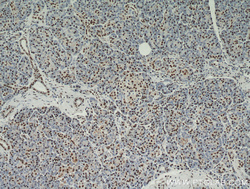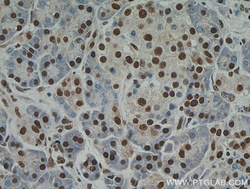21339-1-AP
antibody from Proteintech Group
Targeting: RBM39
CAPER, CAPERalpha, CC1.3, fSAP59, HCC1, RNPC2
Antibody data
- Antibody Data
- Antigen structure
- References [8]
- Comments [0]
- Validations
- Western blot [1]
- Immunohistochemistry [2]
Submit
Validation data
Reference
Comment
Report error
- Product number
- 21339-1-AP - Provider product page

- Provider
- Proteintech Group
- Proper citation
- Proteintech Cat#21339-1-AP, RRID:AB_10733352
- Product name
- RBM39 antibody
- Antibody type
- Polyclonal
- Description
- RBM39 antibody (Cat. #21339-1-AP) is a rabbit polyclonal antibody that shows reactivity with human, mouse, rat and has been validated for the following applications: IF, IHC, WB,ELISA.
- Reactivity
- Human, Mouse, Rat
- Host
- Rabbit
- Conjugate
- Unconjugated
- Isotype
- IgG
- Vial size
- 20ul, 150ul
Submitted references LncRNA MCM3AP-AS1 promotes chemoresistance in triple-negative breast cancer through the miR-524-5p/RBM39 axis.
RBM39 is a potential prognostic biomarker with functional significance in hepatocellular carcinoma.
Optimization of Potent Ligands for the E3 Ligase DCAF15 and Evaluation of Their Use in Heterobifunctional Degraders.
The cancer-testis lncRNA LINC01977 promotes HCC progression by interacting with RBM39 to prevent Notch2 ubiquitination.
Proximity Labeling, Quantitative Proteomics, and Biochemical Studies Revealed the Molecular Mechanism for the Inhibitory Effect of Indisulam on the Proliferation of Gastric Cancer Cells.
Hypoxia-induced long non-coding RNA DARS-AS1 regulates RBM39 stability to promote myeloma malignancy.
Aryl Sulfonamides Degrade RBM39 and RBM23 by Recruitment to CRL4-DCAF15.
Transportin 1 accumulates specifically with FET proteins but no other transportin cargos in FTLD-FUS and is absent in FUS inclusions in ALS with FUS mutations.
Wang Y, Wang X, Sun H, Zhang Z, Gu J
Molecular and cellular biochemistry 2024 Mar 12;
Molecular and cellular biochemistry 2024 Mar 12;
RBM39 is a potential prognostic biomarker with functional significance in hepatocellular carcinoma.
Cui F, Wang W, Zhuang C, He D, Wang P
Translational cancer research 2024 Apr 30;13(4):1606-1622
Translational cancer research 2024 Apr 30;13(4):1606-1622
Optimization of Potent Ligands for the E3 Ligase DCAF15 and Evaluation of Their Use in Heterobifunctional Degraders.
Lucas SCC, Ahmed A, Ashraf SN, Argyrou A, Bauer MR, De Donatis GM, Demanze S, Eisele F, Fusani L, Hock A, Kadamur G, Li S, Macmillan-Jones A, Michaelides IN, Phillips C, Rehnström M, Richter M, Rodrigo-Brenni MC, Shilliday F, Wang P, Storer RI
Journal of medicinal chemistry 2024 Apr 11;67(7):5538-5566
Journal of medicinal chemistry 2024 Apr 11;67(7):5538-5566
The cancer-testis lncRNA LINC01977 promotes HCC progression by interacting with RBM39 to prevent Notch2 ubiquitination.
Xia A, Yue Q, Zhu M, Xu J, Liu S, Wu Y, Wang Z, Xu Z, An H, Wang Q, Wang S, Sun B
Cell death discovery 2023 May 18;9(1):169
Cell death discovery 2023 May 18;9(1):169
Proximity Labeling, Quantitative Proteomics, and Biochemical Studies Revealed the Molecular Mechanism for the Inhibitory Effect of Indisulam on the Proliferation of Gastric Cancer Cells.
Lu J, Jiang H, Li D, Chen T, Wang Y, Pu Z, Xu G
Journal of proteome research 2021 Sep 3;20(9):4462-4474
Journal of proteome research 2021 Sep 3;20(9):4462-4474
Hypoxia-induced long non-coding RNA DARS-AS1 regulates RBM39 stability to promote myeloma malignancy.
Tong J, Xu X, Zhang Z, Ma C, Xiang R, Liu J, Xu W, Wu C, Li J, Zhan F, Wu Y, Yan H
Haematologica 2020 Jun;105(6):1630-1640
Haematologica 2020 Jun;105(6):1630-1640
Aryl Sulfonamides Degrade RBM39 and RBM23 by Recruitment to CRL4-DCAF15.
Ting TC, Goralski M, Klein K, Wang B, Kim J, Xie Y, Nijhawan D
Cell reports 2019 Nov 5;29(6):1499-1510.e6
Cell reports 2019 Nov 5;29(6):1499-1510.e6
Transportin 1 accumulates specifically with FET proteins but no other transportin cargos in FTLD-FUS and is absent in FUS inclusions in ALS with FUS mutations.
Neumann M, Valori CF, Ansorge O, Kretzschmar HA, Munoz DG, Kusaka H, Yokota O, Ishihara K, Ang LC, Bilbao JM, Mackenzie IR
Acta neuropathologica 2012 Nov;124(5):705-16
Acta neuropathologica 2012 Nov;124(5):705-16
No comments: Submit comment
Supportive validation
- Submitted by
- Proteintech Group (provider)
- Main image

- Experimental details
- mouse kidney tissue were subjected to SDS PAGE followed by western blot with 21339-1-AP(RBM39 antibody) at dilution of 1:300
- Sample type
- tissue
Supportive validation
- Submitted by
- Proteintech Group (provider)
- Main image

- Experimental details
- Immunohistochemical of paraffin-embedded human pancreas using 21339-1-AP(RBM39 antibody) at dilution of 1:50 (under 10x lens)
- Sample type
- tissue
- Submitted by
- Proteintech Group (provider)
- Main image

- Experimental details
- The RBM39 antibody from Proteintech is a rabbit polyclonal antibody to a fusion protein of human RBM39. This antibody recognizes human,mouse,rat antigen. The RBM39 antibody has been validated for the following applications: ELISA, WB, IHC analysis.
 Explore
Explore Validate
Validate Learn
Learn Western blot
Western blot ELISA
ELISA